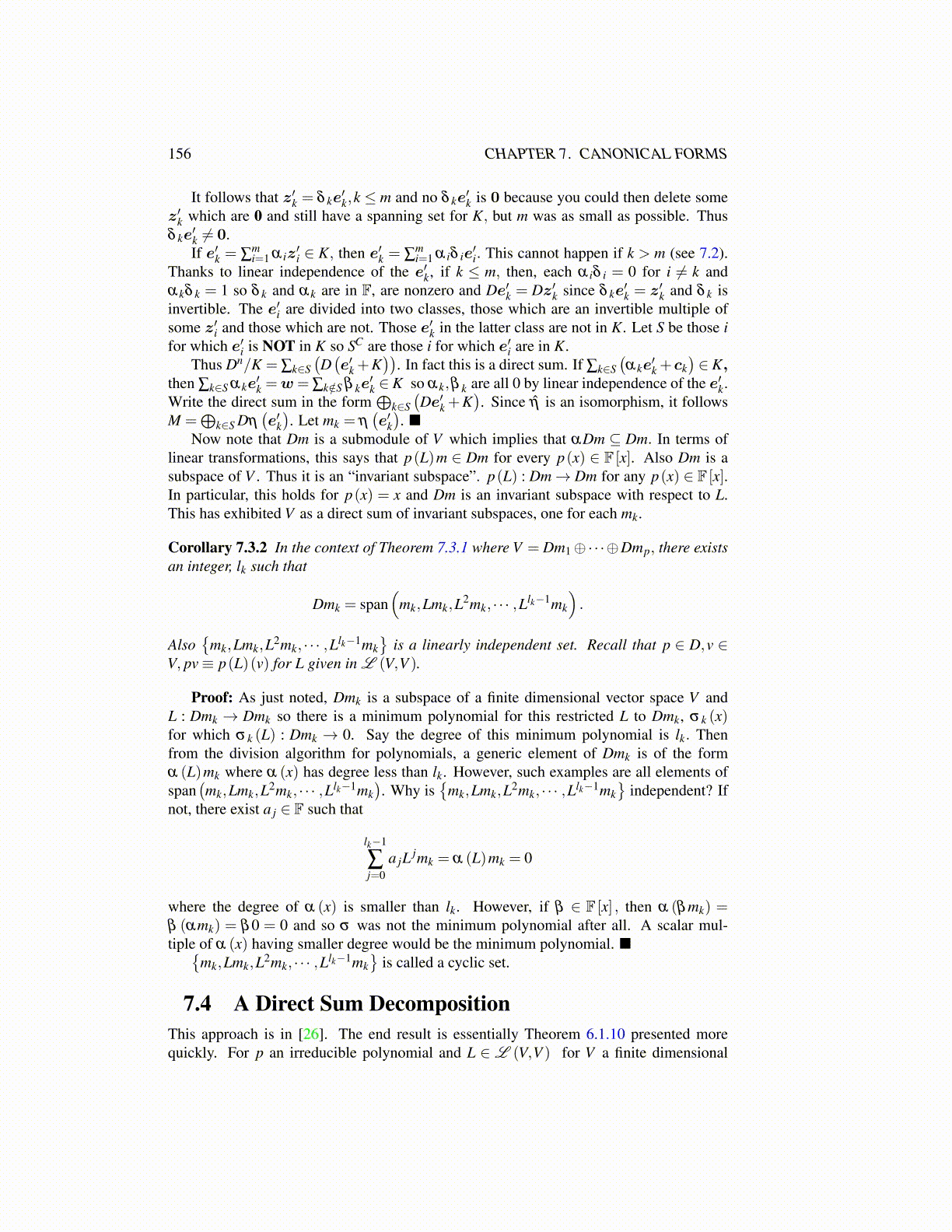
156 CHAPTER 7. CANONICAL FORMS
It follows that z′k = δ ke′k,k ≤ m and no δ ke
′k is 0 because you could then delete some
z′k which are 0 and still have a spanning set for K, but m was as small as possible. Thusδ ke
′k ̸= 0.If e′k = ∑
mi=1 α iz
′i ∈ K, then e′k = ∑
mi=1 α iδ ie
′i. This cannot happen if k > m (see 7.2).
Thanks to linear independence of the e′k, if k ≤ m, then, each α iδ i = 0 for i ̸= k andαkδ k = 1 so δ k and αk are in F, are nonzero and De′k = Dz′k since δ ke
′k = z′k and δ k is
invertible. The e′i are divided into two classes, those which are an invertible multiple ofsome z′i and those which are not. Those e′k in the latter class are not in K. Let S be those ifor which e′i is NOT in K so SC are those i for which e′i are in K.
Thus Dn/K = ∑k∈S(D(e′k +K
)). In fact this is a direct sum. If ∑k∈S
(αke
′k +ck
)∈ K,
then ∑k∈S αke′k =w= ∑k/∈S β ke
′k ∈ K so αk,β k are all 0 by linear independence of the e′k.
Write the direct sum in the form⊕
k∈S(De′k +K
). Since η̂ is an isomorphism, it follows
M =⊕
k∈S Dη(e′k). Let mk = η
(e′k). ■
Now note that Dm is a submodule of V which implies that αDm ⊆ Dm. In terms oflinear transformations, this says that p(L)m ∈ Dm for every p(x) ∈ F [x]. Also Dm is asubspace of V . Thus it is an “invariant subspace”. p(L) : Dm→ Dm for any p(x) ∈ F [x].In particular, this holds for p(x) = x and Dm is an invariant subspace with respect to L.This has exhibited V as a direct sum of invariant subspaces, one for each mk.
Corollary 7.3.2 In the context of Theorem 7.3.1 where V = Dm1⊕·· ·⊕Dmp, there existsan integer, lk such that
Dmk = span(
mk,Lmk,L2mk, · · · ,Llk−1mk
).
Also{
mk,Lmk,L2mk, · · · ,Llk−1mk}
is a linearly independent set. Recall that p ∈ D,v ∈V, pv≡ p(L)(v) for L given in L (V,V ).
Proof: As just noted, Dmk is a subspace of a finite dimensional vector space V andL : Dmk → Dmk so there is a minimum polynomial for this restricted L to Dmk, σ k (x)for which σ k (L) : Dmk → 0. Say the degree of this minimum polynomial is lk. Thenfrom the division algorithm for polynomials, a generic element of Dmk is of the formα (L)mk where α (x) has degree less than lk. However, such examples are all elements ofspan
(mk,Lmk,L2mk, · · · ,Llk−1mk
). Why is
{mk,Lmk,L2mk, · · · ,Llk−1mk
}independent? If
not, there exist a j ∈ F such that
lk−1
∑j=0
a jL jmk = α (L)mk = 0
where the degree of α (x) is smaller than lk. However, if β ∈ F [x] , then α (βmk) =β (αmk) = β0 = 0 and so σ was not the minimum polynomial after all. A scalar mul-tiple of α (x) having smaller degree would be the minimum polynomial. ■{
mk,Lmk,L2mk, · · · ,Llk−1mk}
is called a cyclic set.
7.4 A Direct Sum DecompositionThis approach is in [26]. The end result is essentially Theorem 6.1.10 presented morequickly. For p an irreducible polynomial and L ∈ L (V,V ) for V a finite dimensional